The display was seen at and/or just after high noon from eastern Nebraska about 41 degrees north, on November 7. My sister had called about some geese at a refuge nearby and wanted to go photograph them. I was going to visit my parents, like I often do, and decided I may as well take my camera gear with so if I went to the refuge I’d not have to stop back home. This is the only reason I even had photo gear with me. I stepped outside to do something, and right away saw the parhelic circle extending out a ways, something I’ve never seen before and I have at least seen a number of optics displays now (lunar fog bows, light pillars, lunar vivid coronas, etc)….so I look often enough for stuff. I pointed it out to my uncle as I sprinted for my car to get my gear and he thought, “it’s not just a cloud”. I said no, it’s an arc, watch. I took my camera and sprinted up the hill behind the house.
I soon was seeing “sun dogs” on the parhelic circle. I then was clearly seeing the Wegener arc inside the parhelic circle. It was very vivid as with my eyes I could clearly see the rainbow colors. To be honest I never did see the Heliac arc before. I was flipping through pictures inside later and it simply jumped out. I was like, what is that arc..then looked it up.
The top of the 22 degree halo visually looked crazy most of the time. Very clear and colorful and odd arcing. I thought it was just an intense circumscribed arc in there but it didn’t look placed right and like more was happening. ( 1 – 2 – 3 – 4 – 5 )
The show only lasted 30-40 minutes I’d guess. Then it was pretty hard to get any optics at all. What was strange was visually nothing much was changed about the sky. I was watching for hours so there were different periods of less contrail garbage blocking out the sun. I had friends in Omaha, 20 miles south, and Lincoln another 45 miles south of that, looking too. They never saw anything good. They watched till sunset too, but they also didn’t get out as soon as I was and that was the best part. I wonder what I missed before I got out.
The satellite loop for that day may give the key ( 6 ). I’m located in eastern NE which is at the top center. It was much like the crystals you get right behind a blizzard in air just where it is clearing behind the storm. You can see a more puffy nature to the clouds, they pass and the ice crystals are left in the air. That stuff on satellite is below typical cirrus level/flight level…but still up there. It for sure was different than normal cirrus. A lot of that “cirrus” in the shot is left over form all the contrails. Once the sun got lower you could see the moisture/clouds clearly below the contrails. So anyway, probably worth noting the clouds coming across at the time were more along the lines of mid-level clouds/moisture.
Mike Hollingshead

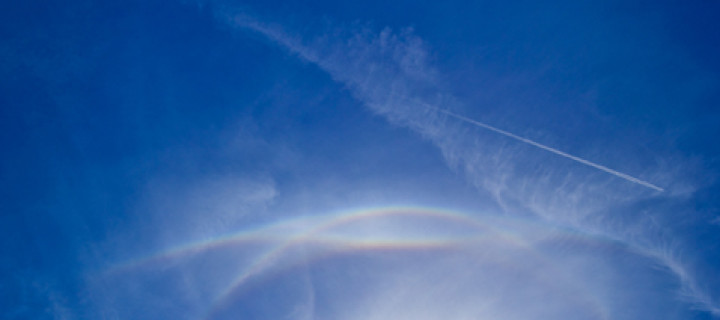
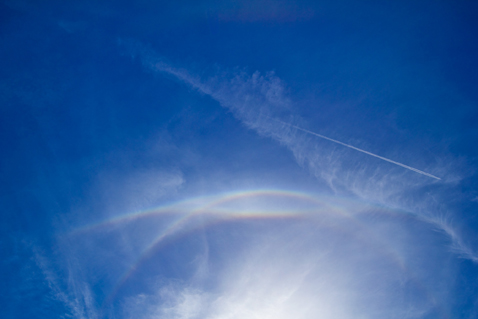
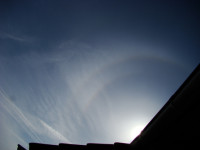
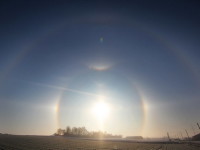
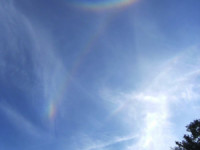
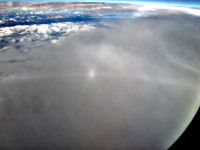
woh! these are the perfect lowitz, lowitz 46deg contacts arc are even clearly present below cza!
is there any other picture of the cza/contact arcs area??
it reminds me of what i got in normandy in 1998, little 22deg halo, but strong UTA, parry suncave and lowitz crossing together!
Wau! Nice catch! The Parry-Lowitz is incredible. Congratulations, Mike!
The upper tangent arc is quite strong as well, so I’d vote for a supralateral arc below cza. But who knows.
if it was supralateral it should be tangent to cza, while it is clearly separated. and i don’t believe in 46deg halo, so it must be 46deg lowitz contact arc, which is really extraordinary!
THAT IS AWESOME!!!! This shows you don’t always need diamond dust. Thats a superb display love the lowitz arc a lot!!! Hope more of these keep coming I got wegener arc this week.
Nicolas, you’re right – it is separated. I didn’t look carefully enough while writing the comment. Anyway, such a sight is typical and is most likely due to tilting plates. But as well it could arise from Lowitz orientation, sure. With such a short piece of arc, however, it is difficult to make a definite identification of 46 contact arcs.
This is grazy display. Has anyone made simulations of the 46 halo / contact arc issue?
It was asked about if any other pics of the cza area. Here is one showing the arcs a bit better there that I don’t think has been posted on here…
http://www.extremeinstability.com/stormpics/2010/2010_11_07_09794a.jpg
Same image USM’d to death. http://www.extremeinstability.com/stormpics/2010/2010_11_07_09794usm.jpg
Most of what I got is on the site on this page, labeled with help from Marko and Ágnes….as well as Les… http://www.extremeinstability.com/2010-11-7.htm I hope the 46 degree halo is right as I don’t want to change labels again lol. I knew better than to mess with the page for it until I had a handle on the names but I never listen to myself.
Wow!! Those are very bright lowitz arcs! That’s a very great display.
I can’t really say the arc below the circumzenithal arc is not a part of the 46 degree contact arcs, but I’m pretty sure it is mostly a 46 degree halo. In the first picture, the arc faintly extends down toward the parhelic circle. There are intensity variations near the top which could be contact arcs.
I tried some simulation. i did not put any randomly oriented crystal (so no 46deg halo on simulation)
http://img42.imageshack.us/img42/6379/contactfr.jpg
all the 46deg arcs are contact arcs.
so i think it confirms that it is mostly 46deg contact arcs on Mike’s pictures
nicolas
That simulation matches the intensities of the halo and the appearance of it very well, Nicolas. I wouldn’t have a hard time believing they are 46 degree contact arcs.
I think, here is Hastings arc too. Use unsharp mask to image “1mike”.
ok, i am now more or less convinced that it is actually mostly 46deg halo!
marko’s simulation shows well that you can get a relatively well visible 46deg halo while 22deg is weak.
and i have processed some of mike’sc picture to show the arc better and there is no trace of the curvature which should be present for contact arcs:
http://img20.imageshack.us/img20/787/redgreeno.png
I made also a simulation which Mike put on his page (at the moment I have no site in the internet)
http://www.extremeinstability.com/2010-11-7.htm
The patch under the cza in the simulation is made both of 46 contact arc and 46 halo, the former from so called Parry-Lowitz orientation, where the equilibrum position of the crystal is basal faces vertical and the latter from poorly oriented plates. The 46 halo rays dominate in simulation.
Simulations aside, because in the photo there is no charasterictic sunvex shape of the upper 46 contact arc, I’d rather see it as 46 halo.
In general, Parry and Lowitz crystal areas in high clouds are usually small in extent, we hardly ever see simultaneously Parry arcs and Tape arcs as we do in diamond dust. In Mike’s display it is possible that the best Lowitz crystals did not span simultaneously the 22 and 46 region.
Good point Patrik. I don’t see the Hastings / Wegener separation that appears in Nicolas’s simulation closer to the sun. But H and W overlap where the arc shows in the photo, so probably the arc is a combination of both.
That is a great display! That Lowitz-Parry compination is a killer!
I think we should see some outward curvature or other components of 46 contact arcs if we want to identify that 46 degree stuff as 46 contact arc. As Marko point out, it probably has both ray paths. These “top bright 46d halos” are not uncommon. Many older cases has been lacking clear Lowitz arcs.
Here is one “top bright 46d halo”:
http://www.atoptics.co.uk/fz162.htm
(the moon display)
This Hollingshead’s display is such a milestone that it should be become christened by its location, like “Saskatoon” or “Kuusankoski”. Where this was seen, more exactly?
I know I have gotten Parry Lowitz combo but nothing like that though. In 2004 I got all 3 lowitz arcs and I think two years ago I got both parrys at once.